|
Welcome to the Summer issue of the LIFE Dee River newsletter!
|
|
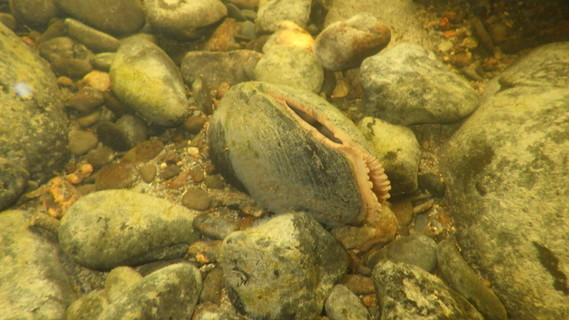 If you have been following our social media recently, you will have seen that the team have been out trying to find adult Freshwater Pearl Mussels, which can be difficult to come across as they are a critically endangered species in Wales and are on the brink of extinction in the wild in the UK.
The freshwater pearl mussel is one of the longest-living invertebrates in existence (it can live over 125 years!) and is extremely rare in the UK. They live on the beds of clean, fast-flowing rivers, where they nestle into coarse sand or fine gravel within stable cobbles and boulders. They feed by drawing in river water and ingesting fine particles of organic matter.

They have a fascinating life cycle; their larvae attach to the gills of salmonid fish and ‘hitch a ride’ for up to 10 months of the year. When they are ready, they drop off and attach themselves to the river bed. At around 3-5 years they will have developed gills and will be able to filter free-flowing river water. The mussels do not mature sexually until the age of 12-15 years, or about 65mm long. Each female can produce up to 4 million larvae which are released into the water column every May-June.
|
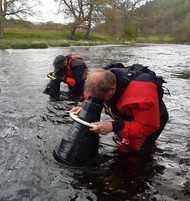 |
|
The Dee population is at critical status, so as part of the LIFE Dee River project, we have been carrying out surveys at various locations within the catchment. Over the last few weeks, and after a lot of meticulous searching, the team were delighted to discover several adult freshwater pearl mussels, using an underwater viewer called a bathyscope, which eliminates water surface reflection and allows under water viewing as far as water clarity and light permits. |
The aim is to collect and use these ageing adult mussels as part of a captive rearing programme to increase the number of juveniles in the Dee. The long-term goal is to help re-establish a healthy, self-sustaining breeding population in the river and promote a lasting recovery in the hope of preventing extinction.
|
|
|
Working on the LIFE project has given us the unique opportunity to look at lamprey on the Dee in much more depth than previously, as they have not been targeted for monitoring in the past. As sea lamprey (Petromyzon marinus) is one of the target species within our project, we have been able to put in place a new monitoring programme to start capturing valuable data which will help improve our understanding of this prehistoric species.
With limited baseline data available from previous years, the run of river lamprey (Lampetra fluviatilis) this spring occurred earlier than we had expected, but allowed us to carry out a trial run to test our data collection methods including trapping, tagging and the deployment of acoustic receivers throughout the catchment. We successfully tagged three adult river lamprey and have detected some of these tags moving upstream. The trial proved useful in testing the reliability and timing of our processes, and we look forward to carrying out more robust monitoring over the next run of river lamprey.
 River lamprey - Jack Perks Photography
We were pleased to share a short video on our Facebook page LIFEAfonDyfrdwy recently, taken by angler John Lewis, and his son Gethin, who discovered several hundred river lamprey accumulating to spawn in the lower Dee. We rushed out the following morning to survey the area, and with low river levels and clear water this allowed us to spot their spawning locations. With such clear conditions, we were able to deploy the team’s drone and capture aerial footage and images of the river lamprey ‘nests’ or ‘redds’ which were much easier to see from above. Wildlife photographer, Jack Perks, was also keen to capture some underwater footage of lamprey spawning in action and came over from Nottingham to make the most of this rare opportunity. With thanks to John and Gethin for informing us, and Jack Perks for sharing some of his images with us. Jack’s lamprey spawning footage was also featured on BBC Springwatch on 9 June and can be watched again here around 23 minutes into the programme.
In the following week, walk-over surveys were undertaken in a few lower Dee locations thought to hold potentially good gravels and that were shallow enough to visually observe spawning redds. A few hundred spawning fish were discovered, and some huge redds (several metres long and wide) were recorded and photographed (both in river and with the drone). This is excellent baseline data for the project as we try to increase the number and range of both river and sea lamprey, of which 2021 appeared to be a very successful spawning year for the former.
|
|
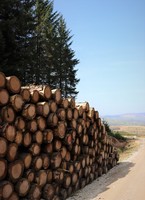
Planning work is currently underway at the Aberhirnant and Llangower forestry block to improve culvert management. This will include replacing 9 dysfunctional culverts which are in poor condition as well as installing an additional 3 new culverts. Sediment traps will also be introduced or improved upon at 34 locations along the forestry road. This improved culvert management will reduce the amount of sediment and other contaminates from entering watercourses, and will allow for forestry operations to be carried out more sustainably.
|
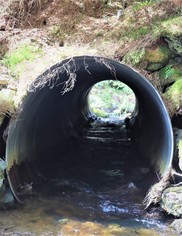
The culverts provide protection to aquatic species by catching additional sediment and diverting it into designated areas of the forest creating wet flushes and sumps for the excess water. The flush areas will be managed in future forest resource plans which includes the removal of conifer trees that will not thrive in the wetter areas and allow deciduous native species of willow and alder to populate instead.
Creating sediment traps involves excavating a hole above or below a culvert in order to interrupt the flow of the water which enables sediment particles to settle, whilst still allowing water to pass through the outflow leaving all the sediment behind in the trap. The design consists of a small temporary retention ponding area, which can then be emptied when full. This work will be completed by September this year.
|
|
|

Fish tagging work has continued for the LIFE team over the past few months, with Atlantic salmon (adults at Chester, and juveniles in the upper tributaries) and sea lamprey being targeted. The network of receivers deployed throughout the river will detect these acoustic tags which have been surgically implanted and allow us to understand the movements of these fish as they migrate as part of their spawning runs, and assess any delays in their journey.
|
Initial indications from receivers in the lower river suggest that both adult salmon and sea lamprey are migrating quickly through the lower section of the river to the Alyn junction, with almost all fish taking less than 12 hours to travel this 14km of river.
 Sea lamprey tagged at Chester
Data from further receivers will be downloaded over the coming weeks to gain a better understanding of the movements of fish throughout the system. The receivers will be left in the river, as the larger tags used in the adult salmon will last for over 18 months, so we will also be able to look at the downstream movement of kelts (the terms given to salmon once they have spawned).
Read about our recent acoustic fish tracking work in a recent case study published by one of our suppliers, RS Aqua, in ECO Magazine here.
|
|
|
We're delighted to be working with North Wales Photography by Simon Kitchin, who will be capturing high quality photos of the beautiful Dee catchment across all four seasons for our project. Our hope is that these range of images reflect the many different uses of the river, and the important role it plays in not only supporting the environment, but also livelihoods and recreation in the area.
You may have already seen some of Simon’s striking images on our Facebook and Twitter, and we have also just launched a new Instagram page to showcase all the best images from the project – please do follow us for all the latest updates!
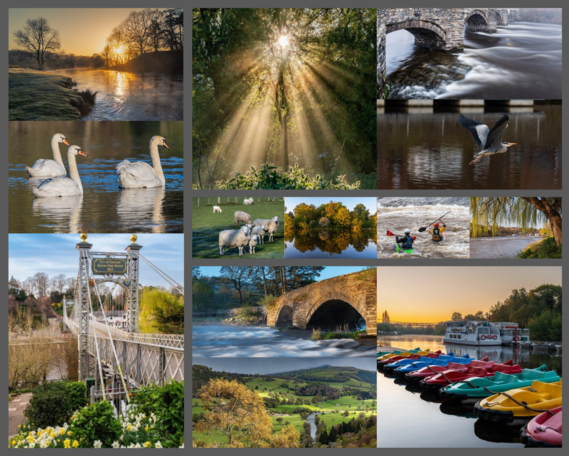
|
|
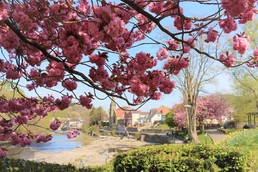
• Award the River Restoration framework contract and plan delivery of this year’s work to be carried out by contractors.
• Continue planning and liaison with stakeholders on the proposed work on two weirs in Llangollen.
• Begin on-farm interventions at targeted sites to reduce nutrient run-off.
• Remove Morlas ford barrier and carry out monitoring on Morlas brook to gather further baseline data.
|
|
|
|
|
|